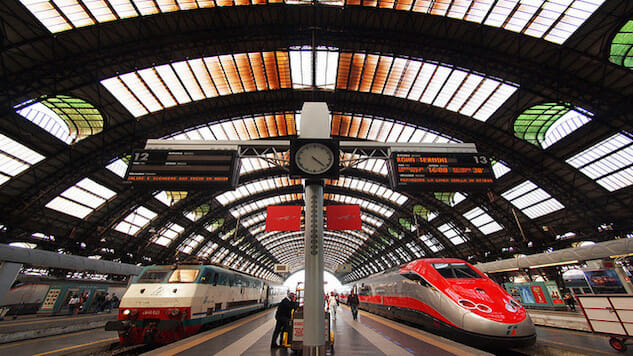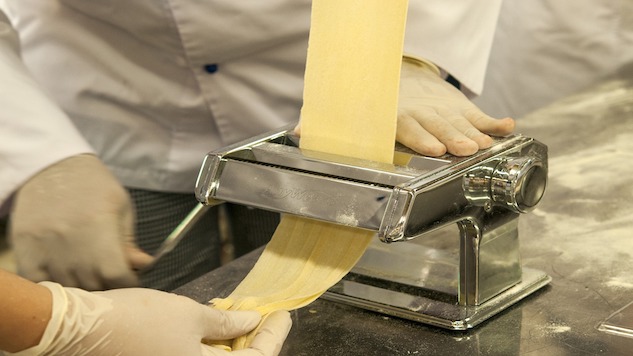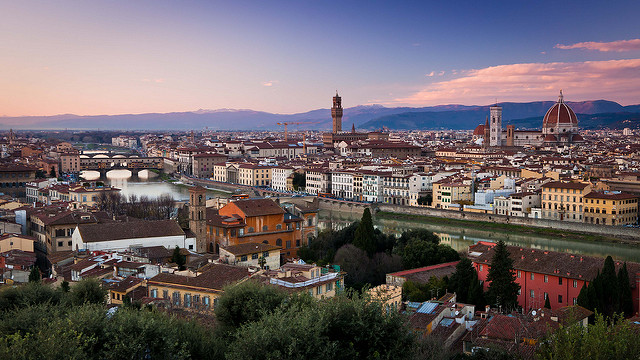
Rolling across Italy on Rail Europe’s state-of-the-art high speed railways means visiting cities—both large and small—in a matter of hours. Moving at speeds of up to 220 mph, riding the rails has the appeal of slow travel with the convenience of modern immediacy. A journey from Venice to Rome can be made in just under 4 hours if anyone cared to blur through half the Italian peninsula.
Rail Europe offers airline-like services with lounges and classes of seats (though all of which are infinitely more comfortable) while cutting down on cost, overall travel time and, importantly, a passenger’s carbon footprint. And best of all: once you’re onboard, you can sit back and just enjoy the scenery. The complimentary coffee cart offers an energy jolt to make working in transit via the car’s WiFi pleasurable. Terminals are nearly always well located in city centers, which only require a short taxi drive or walk to any hotel or attraction.
While Italy’s history could consume a lifetime of study, first-time and returning visitors can reach beyond the mundane to experience each city’s specialty. Come on board with Paste Travel to ride the Italian rails from Milan to Rome with some of our favorite stops along the way.
![]()

Photo by: Paul Bica, CC BY 2.0
Milan
Though the city dates to 400 BC, Milan is undoubtedly modern. As one of the world’s leading fashion capitals, attention to design and fashion begins upon arrival. Over 360,000 people progress through Milano Centrale and on to their destinations via the 600 railcars that embark on its tracks. Dating to 1906, Milan’s main depot boast architectural styles such as Liberty and Art Deco.
Though the square could be identified by its duomo and the Galleria Vittorio Emanuele II, the Milanese aesthetic is also found on the street. Valentino, Versace and Prada are just a few of the fashion houses headquartered here. From clothing design of all types—men’s, women’s, swimwear, accessory—to vintage restyling and textile workshops, try a short course at the Milan Fashion Campus. The school even plans trips around Fashion Week to fold fashionistas into the scene.
Where to Stay: The Westin Palace
Where to Eat: Contraste

Photo by: Benh Lieu Song, CC BY-SA 4.0
Venice
Cross northeastern Italy into the Veneto region and its capital, which consists of 117 islands separated by canals and linked by bridges. Though inhabited since the 10th century BC, Venice was a maritime port from the 13th to 17th centuries specializing in silk, grain, spices and art. Emerging in the 9th century, this city-state became known as the first international financial center and remained wealthy throughout most of its history. While highlights include the Grand Canal, the Bridge of Sighs and Piazza San Marco featuring St. Mark’s Basilica completed in 1092, glass work is the district’s calling card.
Venetian glass is fashioned on the island of Murano. Reputed for its colorful beauty and elaborate designs, glassmaking requires a dexterous artist. Influenced by Byzantine craftsmen fleeing both the Fourth Crusade in 1204 and the Ottoman attack on Constantinople in 1453, most characteristics of the glass were developed in the 13th century. Today travelers can come to know aspects of the art from fusing to lamp working on the island at La Scuola del Vetro, the school of glass. The institutions’s first iteration with a focus on drawing opened in 1862 and has taught artists ever since.
Where to Stay: Centurion Palace
Where to Eat: Da Mamo

Photo by: Miroro, CC0
Bologna
Bologna’s center has come a long way since the first rendition from the Etruscans and the Celts. This languid stop along the route to Rome grants visitors a reprieve from Italy’s metropolises. Exchange Vespas and crowded streets for “motor valley,” set among culture and food. Lamborghini, Ferrari and Maserati are all easily accessible with a shuttle service. From the leaning tower to hidden canals, Bologna is on track to becoming a new favorite among guests.
To truly experience classic Bologna living one must include Bolognese cooking. Sign up for a morning of culinary practice or reserve a private class in the evening. Though Bologna Cucina offers courses to become a professional chef, a commis may choose the wine pairing or pasta-making class. Once the technique is perfected and the pasta is in the oven, sit back with a glass of vino and make friends with the chef. Indulge in the meal you have prepared and part “the Italian way” with a hug and a kiss.
Where to Stay: Art Novecento
Where to Eat: Ristorante Al Sangiovese

Photo by: Benson Kua, CC BY-SA 2.0
Florence
Glide under the Apennines, into the 1932 Firenze Santa Maria Novella station and head for the taxi line. The capital of Tuscany was a center of medieval European trade that now sees 13 million visitors each year. From the Galleria degli Uffizi to the Santa Maria del Fiore Duomo, Florence serves as a hallmark of art and craftsmanship. Known for leathers since the 13th century when tanners and dyers worked along the Arno river, authentic products can be found on street corners and luxury stores alike- though the quality undoubtedly differs. If nothing catches your eye and steals your heart, then manufacture it yourself.
In a Medici-commissioned monastery, the Scuola del Cuoio has been attended by many acclaimed guests from the Royal Families of England to Steven Spielberg. Introduced in the 1930s to provide orphaned children with a trade and means to live, the leather school taught gifted apprentices to gild. Master craftsmen would eventually gild a desk set for former President Eisenhower. Try your own hand at making a book cover or handbag with a short-term course.
Where to Stay: Hotel Savoy
Where to Eat: La Mènagère

Photo by: Alessandro Bonvini, CC BY 2.0
Rome
The Eternal City is home to 4.3 million residents and is the third most-visited city in the European Union. Optimize transit time at Roma Tiburtina with a short cab ride after disembarking one of the 140 high-speed trains that frequent the railway post. With a history that spans more than two and a half thousand years, you’ll need all the time you can get. From Palaeolithic and Neolithic sites to the legend of Romulus and Remus, Rome’s concrete and mythical development is evident throughout its piazzas. Edifices, fountains and mosaics depict public memory. As early as the Republican period or 2nd century BC, tessellated Roman mosaics can be found in pathways, public and private buildings.
The appeal of crafted mosaics is that each composition is unique. Immerse yourself in a historic culture through one of their many art forms in the Cradle of the Renaissance by fabricating your own mosaic self-portrait or an ancient illustration with Studio Cassio. A short walk from the Roman Forum and Colosseum, divine or mythological inspiration is sure to find you along the way to the shop.
Where to Stay: Hotel de Russie
Where to Eat: Ristorante Tullio
Top Image: John Picken, CC BY 2.0
Molly Harris is a freelance writer based in Athens, Georgia.